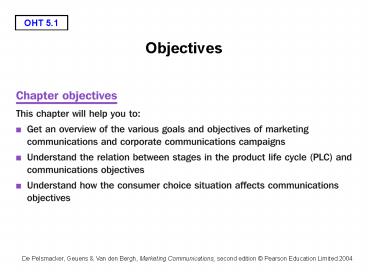Objectives - PowerPoint PPT Presentation
1 / 16
Title:
Objectives
Description:
New York: Association of National Advertisers. OHT 5.5 ... of brand name, logo, style... with. a category need. Top ... Make satisfied customers loyal ... – PowerPoint PPT presentation
Number of Views:50
Avg rating:3.0/5.0
Title: Objectives
1
Objectives
2
Categories of communications objectives
Figure 5.1 Categories of communications objectives
3
Characteristics of a good set of communication
goals
- Fit in with overall company and marketing goals
- Relevant to identified threats or opportunities
- Targeted to different target audiences
- Quantified and measurable
- Comprehensive and motivating
- Timed
- Translated into subgoals when necessary
4
Communications objectives the DAGMAR model
Figure 5.2 Communications objectives the DAGMAR
model Source Colley, R.H. (1961), De?ning
Advertising Goals for Measured Advertising
Results. New York Association of National
Advertisers.
5
Coral Black Velvet developing category wants
Plate 7 Coral Black Velvet innovations call for
communicating category needs (Reproduced with
permission of Gesamtverband Werbeagenturen GWA
and J. Walter Thompson)
6
Brand awareness
- Association of brand name, logo, style... with a
category need - Top-of-mind awareness
- Unaided awareness (recall)
- Aided awareness (recognition)
- There is no such thing as too much brand
awareness
7
Brand knowledge
- Target consumers are aware and understand the
most essential brand characteristics, features
and benefits - They know the brands positioning the strengths
of the brand as compared to competitive brands
8
Brand attitude
- The perceived value of a brand to a consumer
- A brand is stronger when the differentiation with
other brands is bigger
9
Purchase intention and facilitation
- Low involvement products purchase intention
should not be stressed, but purchase facilitation
is important - High involvement products purchase intention
should be developed and trial purchase should be
stimulated
10
Satisfaction and brand loyalty
- Satisfaction when product performance exceeds
expectations - Communicate with existing customers
- Satisfied customers can be advocates of the brand
(word-of-mouth communications) - Reduce cognitive dissonance
- Make satisfied customers loyal
- Brand loyalty mental commitment or relation
between a customer and a brand - Repeat purchase is not the same as brand loyalty
11
Percentage of the target group in each stage of
the DAGMAR model
Figure 5.3 Percentage of the target group in each
stage of the DAGMAR model
12
Criticisms of the DAGMAR model
- Sales fluctuate more than awareness and image
- Sometimes attitudes follow behaviour
- DAGMAR is only about converting non-buyers into
buyers most advertising is directed at
experienced consumers - DAGMAR is based on the strong theory of
advertising effectiveness - ATR weak theory
13
Stages in the product life cycle and
communications objectives
Figure 5.4 Stages in the product life cycle and
communications objectives
14
Factors affecting the consumer choice situation
Figure 5.5 Factors affecting the consumer choice
situation
15
Types of choice situations (products)
- Standard mass products
- Standard services
- Mail order products
- Impulse products
- Quality products
- Quality services
- Unsought products
- International luxury products
- Special niche products
- Showroom products
- Products with new techniques
- Investment products
16
Corporate communications objectives
Figure 5.6 Corporate communications objectives































